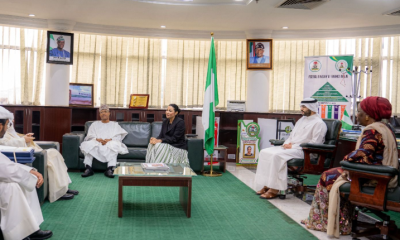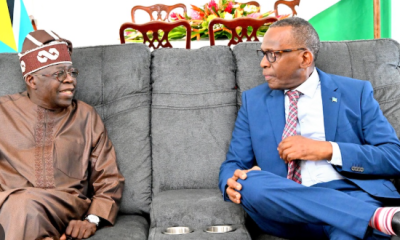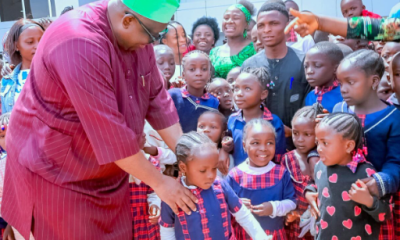Education
Is virtual reality a bonus to education?
Published
8 years agoon
By
Olu Emmanuel
Currently there are new virtual reality tools in the educational sector. The consesus is out whether the technology lives up to its hype.
There are some K–12 classrooms using virtual or augmented reality, there are estimates that the technology could reach 15 million students by 2025.
Computer scientists began to experiment with “virtual experiences” in the 1950s, and by the 1980s goggles and gloves had been developed to simulate immersion in a virtual world.
An educational blogger Audrey Watters asks the question “ How is virtual reality different from educational films?” She likes to deliberate upon the role of technology in education: her blog is titled Hack Education.
“I do worry that we’ll increasingly substitute watching a movie—under the guise of simulation or VR—for field trips and other offline enrichment opportunities that are more meaningful.”
It’s not cheap to provide access to all svhlols because the equipment can be quite pricey. The headsets and gloves can cost hundreds while cheaper versions exist—such as the $15 Google Cardboard, which attaches to a smartphone—of course quality of experienceisn’t the same.
Critics say much of what is now called virtual reality by schools isn’t experienced through headsets and gloves, but on laptops, tablets, and phones instead. A lot of people aren’t sure exactly what VR entails, and the definition evolves.
VR advocates like Maya Georgievabelieves thatvirtualreality is mostlysupplementalinK–12classrooms,but this is changing asthevolumeofcontentincreasesandteachersandstudentsfeeltheexcitementaroundit.
Georgievais the co-founder of Digital Bodies—a group that researches and consults on VR for education. She says the following“We are hearing from educators that students are asking more questions and are more engaged in their learning”
It’s critical to show children visual models of what they are learning;virtual reality provides them with building blocks.
Proponents of the technology pinpoint to actual success stories: Below are some of the more promising uses of VR.
Making science come alive
Some doctors have been using VR to assist in surgeries and pinpoint ailments—by generating 3D models of real patient tumors from MRI scans.
Now some science teachers state that VR enables deeper understanding of subjects such as biology and anatomy, where students need to grasp the inner workings of cells and organs that are not visible to the human eye.
In a school in California, a high school biology teacher, Rebecca Girard has been using mixed reality computers from zSpace—which come with special glasses that allow cells and organs to “pop out” of the flat screen in 3D—to help her students gain a better grasp on how the heart works. Hee students can follow the path of blood flow through arteries as the heart beats, watching valves open and close.
“Real organs used in dissection are preserved and inflexible, and the valves and muscle no longer pump,” Girard said. “I have been teaching biology for 22 years, and I have never had students understand the structures, relationships, and orientations of the organs with the same clarity as when they are viewed virtually
Virtual campus tours
It is expensive and time-consuming, not always feasible for lots of potential college students. Some apps like Campus Tours and YouVisit are now offering 360-degree virtual reality tours for hundreds of campuses, from the Georgia Institute of Technology to the University of Minnesota. They state that the experience helps foster a “sense of familiarity and belonging” for students who can’t make the trip—and aids students to sift through more schools.
Using any device (no fancy headset needed), prospective students can “walk” on the paths around campus and “see” themselves among other college students, headed to class or back to the dorms. By clicking on campus buildings, users can get inside and access more than 1,000 college experiences like exploring Geisel Library at the University of California, San Diego, or an electrical engineering lab at Princeton University.
“It’s human nature to want to really look around a place and get a genuine sense of what it’s like,” said Gordon Meyer, director of marketing for YouVisit. “By being immersed in the experience; students feel like they are in the campus.
Technical classes revamped
Unfortunately fewer students are taking technical courses these days. We are hopeful that they may get revitalized through new virtual reality experiences that train students how to repair cars and allow them to complete safety training in 3D.
The Hong Kong Institute of Vocational education used VR to teach aircraft engineering and building maintenance skills.
VR will never be a replacement for an actual field trip; however it does provide an opportunity for a new level of immersion.
Help us with our mission to bring about change for our students. Please contact me to see what we can do to bring about the desired transformation that we all desire for our children to be future ready!!!
Adetola Salau; Educator / Speaker / Author/ Social Entrepreneur / Innovator
She is an Advocate of STEM Education and is Passionate about Education reform. She is an innovative thinker and strives for our society & continent as a whole to reclaim it’s greatness. She runs an educational foundation with the mission to transform education.
E-mail-:[email protected]
facebook-: Carisma4u
twitter-: @Carisma4u
Website-: www.carisma4u.com
You may like


Federal Government secures $25.35m Kuwait fund loan to tackle out-of-school children in Kaduna


Anambra State government approves N3.6bn contracts for infrastructure, restores ‘Abakaliki street’ name


Academic ties strengthen as JOSTUM hosts new Benue varsity VC


Oyo state orders 202 unintegrated teachers back to LGUBEAs


Nigeria, Saint Lucia to establish formal diplomatic ties as Tinubu meets Prime Minister Pierre


Children, Plateaus’ greatest treasure says Mutfwang
Trending

 Latest5 days ago
Latest5 days agoReactions follow US strikes on terrorist targets on Christmas Day

 Latest7 days ago
Latest7 days agoNigeria’s kidnap-for-ransom industry nets N2.57bn in one year

 News4 days ago
News4 days ago2027: Lagos Lawmaker Bonu galvanize support for Tinubu’s reelection, initiates fitness walk for Constituents Wellness, Unity

 Energy1 week ago
Energy1 week agoDiesel, petrol prices ease year-on-year despite monthly fluctuations — NBS

 Comments and Issues1 week ago
Comments and Issues1 week agoWhen police do the right thing

 Business1 week ago
Business1 week agoNIN now serves as tax ID for Nigerians under new tax regime — FIRS, experts clarify

 Latest6 days ago
Latest6 days agoPresidency debunks viral claim of change in Tinubu’s Chief of Staff

 Health1 week ago
Health1 week agoStudy shows higher mortality rates among vaccinated infants

